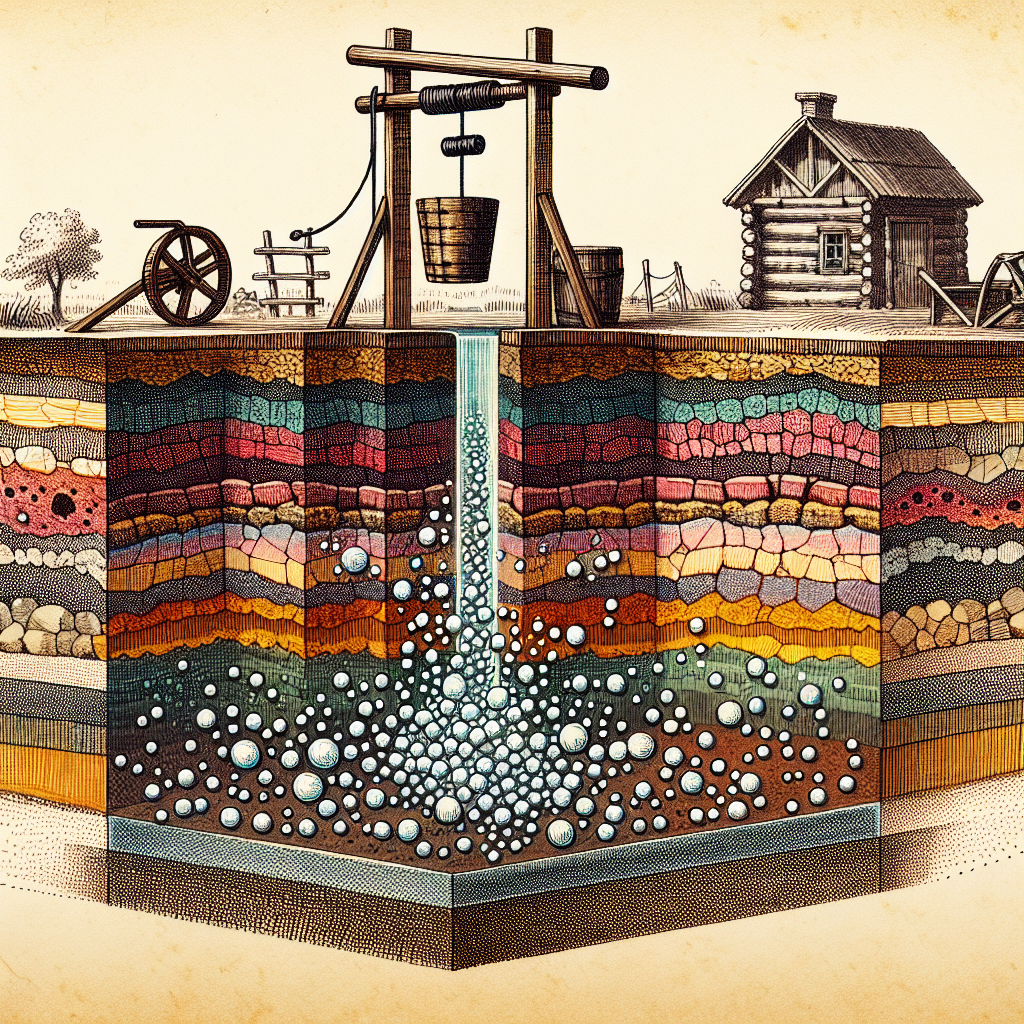Are you concerned about the levels of sulfates in your well water? This article explores the topic of safe levels of sulfates in well water and the potential risks associated with high sulfate concentrations. Whether you rely on well water for drinking, cooking, or irrigation, it is crucial to understand the potential impacts of sulfates on your health and the environment. So, let’s dive into the world of sulfates in well water and discover what levels are considered safe.

Understanding Sulfates in Well Water
What are sulfates?
Sulfates are naturally occurring compounds that contain sulfur and oxygen atoms bonded together. In well water, sulfates are commonly found in the form of sulfate salts, such as magnesium sulfate (Epsom salt) and calcium sulfate. These compounds are soluble in water, which means they can dissolve and be present in the water supply.
How do sulfates enter well water?
Sulfates typically enter well water through the natural geological processes that occur underground. When water passes through rocks and soil containing sulfates, it can dissolve and carry the sulfates with it. Rainwater can also pick up sulfates as it percolates through the ground and makes its way into underground aquifers, which are the primary sources of well water.
Health concerns associated with sulfates
While sulfates are generally considered to be safe for human consumption at low levels, high concentrations can have potential health effects. One of the immediate concerns is the taste and odor of the water. Water with high sulfate levels may have a bitter or metallic taste, which can be unpleasant for drinking and cooking. In addition, high amounts of sulfates in water can have a laxative effect on the digestive system, resulting in diarrhea and dehydration.
Establishing Safe Levels of Sulfates
Regulatory standards for sulfates
Regulatory authorities, such as the Environmental Protection Agency (EPA), have set standards for sulfates in drinking water. The EPA has established a Secondary Maximum Contaminant Level (SMCL) of 250 milligrams per liter (mg/L) for sulfates. This SMCL is not enforceable but provides guidance to water suppliers in maintaining the quality of water. It is important to note that the primary concern in setting this level is related to aesthetic considerations rather than direct health risks.
Health organizations’ recommendations
Various health organizations, such as the World Health Organization (WHO) and the Centers for Disease Control and Prevention (CDC), have also provided recommendations regarding sulfates in drinking water. According to the WHO, a concentration of up to 500 mg/L is considered to have no significant health risk for most individuals. However, the CDC suggests that individuals who are particularly sensitive to sulfates, such as people with certain medical conditions, may experience adverse effects even at lower concentrations.
Considerations for vulnerable populations
Certain groups, such as infants, young children, pregnant women, and individuals with specific health conditions, may be more susceptible to the potential health impacts of sulfates. This is why it is crucial to pay attention to the safe levels of sulfates in well water, especially when catering to these vulnerable populations. Consulting with a healthcare professional and considering water treatment options may be necessary to ensure the well-being of these individuals.
Potential Effects of High Sulfate Levels
Impact on human health
While sulfate concentrations below the established standards are generally considered safe, higher levels can negatively affect human health. Ingesting water with high sulfate levels may cause gastrointestinal issues, such as diarrhea, dehydration, and stomach discomfort. Sulfates can also have a laxative effect, particularly in infants and young children who are more sensitive to changes in their water source. Furthermore, sulfate-rich water can interfere with the absorption of certain medications, reducing their effectiveness.
Impact on the environment
High sulfate levels in well water can also pose risks to the environment. When water containing sulfates is used for irrigation or discharged into lakes and rivers, it can potentially lead to the contamination of soil and water bodies. Excessive sulfates in these environments can disrupt the natural balance, affecting aquatic plants, fish, and other organisms. Monitoring and mitigating sulfate levels in well water are crucial not only for human health but also to preserve the integrity of the surrounding ecosystems.
Corrosion and other issues in plumbing systems
In addition to health and environmental concerns, high sulfate levels can also impact plumbing systems. Water with elevated sulfate concentrations can lead to corrosion of pipes, faucets, and fixtures. The corrosion process can gradually damage plumbing infrastructure, potentially causing leaks, reduced water pressure, and costly repairs. It is important to be aware of the sulfate content in well water to prevent long-term damage to residential and commercial plumbing systems.
Sulfate Testing and Monitoring
Testing methods for sulfates
To determine the sulfate levels in well water, there are various testing methods available. One common method is ion chromatography, which separates and quantifies ions in a water sample, including sulfates. Another widely used approach is the turbidity test, which measures the cloudiness or haziness of water caused by the presence of sulfates. There are also test strips and kits designed for homeowners to test sulfates at home, providing a convenient option for routine monitoring.
Frequency of testing
The frequency of sulfate testing depends on factors such as the initial sulfate levels, geographical location, and the presence of sulfate-contributing industries nearby. Initially, it is recommended to test the well water for sulfates when first establishing a new well or when moving to a new property with an existing well. Regular testing afterwards can be conducted annually, particularly if there are concerns regarding changes in water quality, such as taste, odor, or discoloration.
Interpreting test results
Once the sulfate test results are obtained, it is important to interpret them correctly. Comparing the results to the established regulatory standards or health organization recommendations can provide insights into the safety of the water. If the levels exceed the recommended limits, well owners should consider implementing appropriate treatments or contacting water treatment professionals for guidance and support.

Treating High Sulfate Levels in Well Water
Water treatment options
When faced with high sulfate levels in well water, there are several treatment options available. The choice of treatment depends on the specific circumstances, including the level of sulfates, the presence of other contaminants, and the individual well owner’s preferences. Some common treatment methods for reducing sulfate levels include reverse osmosis, ion exchange, distillation, and potentially other filtration systems.
Reverse osmosis
Reverse osmosis (RO) is a popular water treatment method that can effectively remove sulfates from well water. This process involves forcing water through a semipermeable membrane, which filters out impurities and separates the sulfates from the water molecules. RO systems are widely available and can be installed at the point of use, such as under the kitchen sink, to provide treated water for drinking and cooking.
Ion exchange
Ion exchange is another common method used to treat high sulfate levels in well water. It involves the exchange of sulfate ions with other ions, such as chloride or bicarbonate, to reduce the overall sulfate content. This process is typically carried out using a resin bed that selectively adsorbs sulfates and releases other ions. Ion exchange systems are often used in combination with other treatment methods to achieve optimal water quality.
Distillation
Distillation is an effective method for sulfate removal, as it involves heating the water to create steam and then condensing the steam to produce purified water. Since sulfates do not evaporate with the water, they are left behind in the boiling chamber. This process can remove a wide range of contaminants, including sulfates, but it may require additional post-treatment to balance the water’s pH and mineral content.
Other potential treatment methods
In some cases, other treatment methods, such as activated carbon filtration or chemical precipitation, may be effective in reducing sulfate levels. These methods involve the use of specific materials or chemicals to bind or remove sulfates from the water. However, the suitability and effectiveness of these methods depend on various factors, including water chemistry, flow rates, and the presence of other contaminants.
Considering Other Factors
Interactions between sulfates and other chemicals
It is essential to take into account the interactions between sulfates and other chemicals present in well water. For example, sulfates can react with certain metals, such as iron, to form insoluble compounds that can contribute to scaling or fouling in plumbing systems. Additionally, the presence of sulfates may affect the efficiency of water treatment processes, especially if there are other contaminants that interact with sulfates in undesirable ways. Understanding these interactions can help in selecting the most appropriate treatment methods.
Water hardness
Water hardness is another factor to consider when addressing sulfate issues in well water. Hard water contains high concentrations of minerals, such as calcium and magnesium, which can react with sulfates. The formation of insoluble compounds can lead to the buildup of scale and reduce the effectiveness of water treatment systems. Therefore, it may be necessary to address both sulfate and hardness issues together to ensure optimal water quality.
pH levels
The pH of well water can also influence the behavior and solubility of sulfates. Water with a higher pH, or alkaline water, tends to have higher solubility for sulfates. In contrast, water with a lower pH, or acidic water, can promote the precipitation of sulfate compounds. Understanding the pH levels of well water helps in assessing the potential impact of sulfates and selecting appropriate treatment methods.
Temperature
Temperature can play a significant role in the solubility of sulfates in well water. Higher temperatures generally increase the solubility of sulfates, while lower temperatures can cause sulfates to precipitate out of the water. It is important to consider the seasonal variations in temperature when monitoring sulfate levels, as well as any potential heating or cooling processes that the water may undergo during treatment and use.

Educating Well Owners
Importance of well maintenance
Educating well owners about the importance of regular well maintenance is crucial to ensure the overall quality of well water. Regular maintenance practices, such as inspecting the well structure, testing the water quality, and maintaining the pumping equipment, can help identify potential issues, including high sulfate levels. Well owners should be aware of the significance of preventive measures and prompt actions to address any water quality concerns.
Signs of sulfate contamination
Well owners should also be aware of the signs that may indicate sulfate contamination in their well water. Besides the obvious changes in taste or odor, other indicators of high sulfate levels include scale buildup on fixtures and appliances, stained laundry or plumbing fixtures, and recurring issues with gastrointestinal discomfort. Being vigilant of these signs can prompt well owners to take necessary steps to mitigate sulfate contamination.
Preventing and addressing sulfate issues
Prevention is key when it comes to sulfate issues in well water. Well owners should consider implementing preventive measures, such as regular testing, proper well construction, and appropriate treatment systems if necessary. By addressing sulfate issues proactively, well owners can ensure the safety and quality of their well water and minimize potential health, environmental, and plumbing risks associated with high sulfate levels.
Risks and Benefits of Sulfates
Potential benefits of sulfates
While there are concerns about high sulfate levels, it is important to recognize that sulfates can also have beneficial uses. Sulfates can enhance the taste of certain beverages, such as beer and wine, and contribute to the preservation and stability of some food products. Additionally, certain sulfate compounds, such as Epsom salt, have been used for therapeutic purposes, including relaxation and muscle relief. Understanding the potential benefits of sulfates helps in weighing the risks associated with their presence in well water.
Recognizing potential risks
Despite the potential benefits, it is crucial to recognize and address the risks associated with high sulfate levels in well water. The laxative effect of sulfates can lead to dehydration, particularly in vulnerable populations such as infants and the elderly. The corrosion of plumbing systems and the environmental impacts of sulfate contamination also pose potential risks. Well owners should consider these risks and take appropriate measures to ensure the safety of their well water.
Balancing health concerns and beneficial uses
Finding the balance between health concerns and beneficial uses of sulfates is essential when considering sulfate levels in well water. Regulatory standards and health organization recommendations serve as guidance to maintain water quality and minimize the risks associated with high sulfate concentrations. Well owners can make informed decisions by considering their specific needs, the potential health impacts, and any potential benefits of sulfates present in their well water.

Future Research and Regulations
Ongoing studies on the effects of sulfates
Ongoing research is being conducted to further understand the effects of sulfates on human health and the environment. Researchers aim to refine the existing knowledge regarding the threshold concentrations of sulfates to better predict and prevent any adverse effects. By investigating the potential interactions between sulfates and other contaminants, future studies may provide insights into the more holistic management of water quality.
Potential revisions to regulatory standards
As scientific knowledge evolves, regulatory standards for sulfates in well water may be subject to revisions to reflect the latest research findings. These revisions aim to provide the most up-to-date guidelines for protecting human health and maintaining environmental integrity. It is important for well owners and water suppliers to stay informed about any potential changes in regulatory standards to ensure continued compliance and safety.
Areas of further research
Several areas of further research need to be explored to deepen our understanding of sulfates in well water. This includes studying the long-term health effects of sulfates, potential correlations between high sulfate levels and certain health conditions, and the impact of sulfate treatment methods on overall water quality. Additionally, research into the effectiveness and efficiency of sulfate removal technologies can help develop more sustainable and cost-effective treatment solutions.
Conclusion
Understanding sulfates in well water is crucial for ensuring the safety and quality of our drinking water. While sulfates are generally considered safe at low concentrations, high levels can have adverse effects on human health, the environment, and plumbing systems. By establishing safe levels, regularly testing and monitoring sulfate levels, and implementing appropriate treatment methods, well owners can effectively manage potential risks and maintain the integrity of their well water. Continued research and regulations will further contribute to our knowledge and guide the development of sustainable solutions for addressing sulfate issues in the future.


